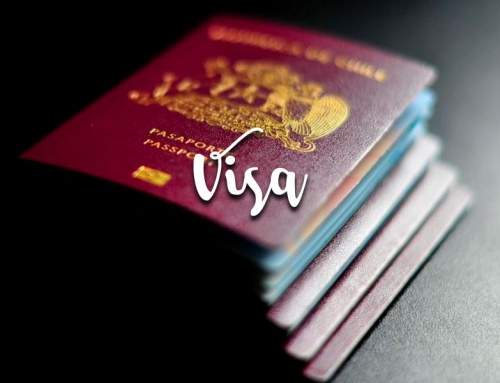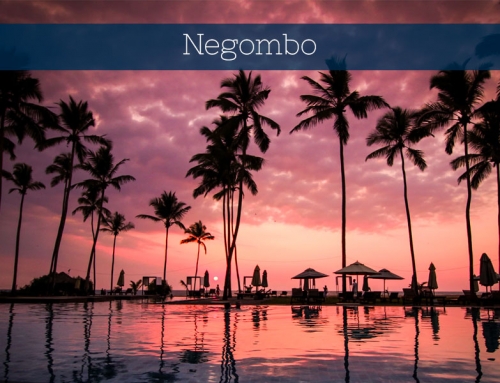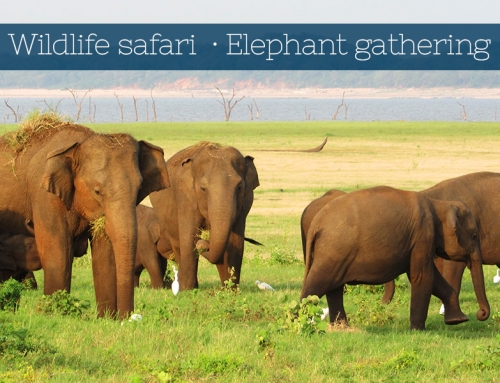Legend and history are deeply intertwined in the early accounts of Sri Lanka. Sri Lanka’s original inhabitants, the Veddahs (Wanniyala-aetto, called Yakshas in the Pali chronicles), were hunter-gatherers who subsisted on the island’s natural bounty. Much about their origins is unclear, but anthropologists generally believe that they are descended from people who migrated from India, and possibly Southeast Asia, and existed on the island as far back as 32,000 BC. It’s also likely that rising waters submerged a land bridge between India and Sri Lanka in around 5000 BC. Historians and archaeologists have differing interpretations of its origins, but a megalithic culture emerged in the centuries around 900 BC with striking similarities to the South Indian cultures of that time. Also during this Early Iron Age, Anuradhapura began to grow as a population centre.
Objects inscribed with Brahmi (an ancient ‘parent’ script to most South Asian scripts) have been found from the 3rd century BC; parallels to both North Indian and South Indian Brahmi styles have been made, though Tamil words are used in many of those found in the north and east of the island. Sri Lankan historians debate these details fiercely, as do many Sri Lankans, but rather than there being two distinct ethnic histories, it is more likely that migrations from West, East and South India all happened during this time and that those new arrivals all mixed with the indigenous people.
The Sri Lankan Buddhist kingdoms flourished by building and controlling irrigation networks on the plains in the northern part of the island. One ancient capital, Anuradhapura, was home to some of the largest and most impressive Buddhist temples of southern Asia. The ruler of another Sri Lankan state, King Kasyapa (r. 473-491) made his capital at Sigiriya, a natural rock fortress rising a sheer 500 feet above the surrounding plain, on top of which the king built an elegant city of palaces and gardens.
King Kysapa and other Sri Lankan kings had to deal with occasional invasions from Tamil Nadu, in southern India, which increased in frequency and severity after around 600 C.E. Sri Lanka struggled, not always successfully, to remain independent of the great Chola Empire that dominated southern India from about 850 to 1279 C.E. A Tamil kingdom was established on the Jaffa Peninsula, in the northern part of Sri Lanka, by the early 13 th century. Meanwhile the center of Sinhalese royal power drifted steadily toward the southern and western parts of the island, and the separate Sinhalese kingdom of Kandy rose to power in the central hills. The division of Sri Lanka into a Tamil north and east, and a Sinhalese south, center and west, is thus not a new phenomenon of the 20th century, but a situation that has existed for hundreds of years.
Trade and the Colonial Era
Long-distance ocean trade in the Indian Ocean region has existed since ancient times. The Roman Empire imported luxury goods from Sri Lanka, including gemstones and cinnamon. Sri Lankan ships sailed as far west as Arabia, and as far east as China. Arab and Persian merchants knew Sri Lanka as the island of Serendib (a word that gives us “serendipity,” meaning “something which comes as a pleasant surprise”). “Treasure ships” sent by the emperor of Ming Dynasty China visited Sri Lanka during the 15 th century.
Sri Lanka began to feel the impact of Europe soon after Portuguese ships found their way to the Indian Ocean at the end of the 15th century. Because Sri Lanka was rich in goods that Europeans wanted, and also because it is a convenient place to stop on the way from Europe to Indonesia and China, Europeans competed to control the island and its trade. The Portuguese conquered Sri Lanka’s coastal cities in the 16 th century but faced fierce competition from the Dutch for control of the island. By 1707 the Dutch had captured the last of the Portuguese forts along the coast and became the main European power in Sri Lanka, but they in turn lost out to the British in 1795-96. By 1818 the British had also defeated the independent inland Kingdom of Kandy, and the whole island of Sri Lanka became part of the British Empire.
Under British colonial rule, the economy of Sri Lanka was transformed to become a producer of agricultural products for foreign trade. Soon the economy was dominated by plantation crops such as coffee, tea, rubber, and coconuts. The British authorities also encouraged the migration of Tamil laborers from southern India to Sri Lanka to work on the plantations. Colonial rule created new elite groups, including plantation managers, intellectuals who took advantage of the opportunity to gain a western-style education, and bureaucrats who worked for the colonial government. But ethnic problems continued to complicate Sri Lankan national life.
Independence
All over South Asia (including today’s countries of India, Sri Lanka, Myanmar, Pakistan, and Bangladesh), resistence to British rule grew rapidly after the end of World War I in 1919. In Sri Lanka, which was comparatively small, stable, and well governed under British rule, the country’s first democratic election was held in 1931. A movement toward economic self-determination leading to full independence was spearheaded by Sri Lanka’s greatest modern leader, Don Stephen Senanayake (1884-1952). When Sri Lanka became independent on February 4, 1948, Senanayake became the country’s first prime minister. He committed his government to the principles of a free, democratic, and multi-ethnic Sri Lanka. However, long-standing problems between the Sinhalese and Tamil communities made it difficult to create a truly multi-ethnic society. Many Sinhalese resented the Tamils as “newcomers” who took jobs and political power away from them (although the ancestors of some Tamils had lived in Sri Lanka for centuries). Many Tamils feared that their rights would be ignored by the Sinhalese majority.
Ages of civil war and birth of L.T.T.E.
In the mid-1970s several groups of young Tamils, some of them militant, began advocating for an independent Tamil state called Eelam (Precious Land). They included Vellupillai Prabhakaran, one of the founders of the Liberation Tigers of Tamil Eelam (LTTE), often referred to as the Tamil Tigers.
Tamil had been elevated to the status of ‘national language’ for official work, but only in Tamil-majority areas. Clashes between Tamils and security forces developed into a pattern of killings and counter-reprisals, all too often with civilians in the crossfire. Passions on both sides rose, and a pivotal moment came in 1981, when a group of Sinhalese men (some say government forces) burnt down Jaffna’s library, which contained, among other things, various histories of the Tamil people, some of which were ancient palm-leaf manuscripts.
Small-scale reprisals followed, but the world only took notice two years later, in 1983, when, in response to the Tigers’ ambushing and killing of 13 soldiers in the Jaffnaregion, full-scale anti-Tamil massacres erupted in Colombo. In a riot now known as Black July, between 400 and 3000 Tamils were clubbed, beaten, burned or shot to death, and Tamil property was looted and burned. Several Tamil-majority areas, including Colombo’s Pettah district, were levelled, and the violence spread to other parts of the country.
The government, the police and the army were either unable or unwilling to stop the violence; some of them assisted. Hundreds of thousands of Tamils left the country or fled to Tamil-majority areas in the North or East – and many joined the resistance. (Many Sinhalese, meanwhile, moved south from the North and East.) The horror of Black July prompted a groundswell of international sympathy for Tamil armed resistance groups, and brought funding from fellow Tamils in southern India, as well as from the government of Indira Gandhi.
Revenge and counter-revenge attacks continued, and grew into atrocities and massacres – on both sides. The government was widely condemned for acts of torture and disappearances, but it pointed to the intimidation and violence against civilians, including Tamils and Muslims, by the Tamil fighters.
Implementation of a 1987 accord, which would offer limited Tamil autonomy, alongside officialising Tamil as a national language, never happened, and the conflict escalated into a 25-year civil war that would eventually claim upwards of 100,000 lives.
Attempts at peace
In 1987 government forces pushed the LTTE back into Jaffna. In an attempt to disarm the Tamil rebels and keep the peace in northern and eastern Sri Lanka, the prime minister, JR Jayawardene, struck a deal with India for an Indian Peace Keeping Force (IPKF). A single provincial council would be elected to govern the region with substantial autonomy for a trial period.
It soon became clear the deal suited no one. The LTTE complied initially before the Indians tried to isolate it by promoting and arming other Tamil rebel groups. Opposition to the Indians also came from the Sinhalese, a revived JVP and sections of the sangha (community of Buddhist monks and nuns), leading to violent demonstrations. In 1987 the JVP launched a second revolution with political murders and strikes, and by late 1988 the country was terrorised, the economy crippled and the government paralysed. The army struck back with a ruthless counter-insurgency campaign. The insurrection was put down, but not before tens of thousands died.
By the time the Indian peacekeepers withdrew, in March 1990, they had lost more than 1000 lives in just three years. But no sooner had they left than the war between the LTTE and the Sri Lankan government escalated again. By the end of 1990 the LTTE held Jaffna and much of the North, although the East was largely back under government control. In May 1991 Rajiv Gandhi was assassinated by a suicide bomber; it was blamed on the LTTE, presumably in retaliation for consenting to the IPKF arrangement.
The 2002 Ceasefire
Although most Tamils and Sinhalese longed for peace, extremists on both sides pressed on with war. President Premadasa was assassinated at a May Day rally in 1993. The LTTE was suspected but never claimed responsibility. The following year, the People’s Alliance (PA) won the parliamentary elections; its leader, Chandrika Bandaranaike Kumaratunga, the daughter of former leader Sirimavo Bandaranaike, won the presidential election. The PA had promised to end the civil war, but the conflict continued in earnest.
In 2000 a Norwegian peace mission brought the LTTE and the government to the negotiating table, but a ceasefire had to wait until after the December 2001 elections, which handed power to the UNP. Ranil Wickremasinghe became prime minister, and economic growth was strong while peace talks appeared to progress. Wickremasinghe and President Chandrika Bandaranaike Kumaratunga, however, were from different parties, and circled each other warily until 2003, when Kumaratunga dissolved parliament and essentially ousted Wickremasinghe and his UNP.
In 2002, following the Norway-brokered ceasefire agreement, a careful optimism reigned. In the North, refugees, internally displaced persons and long-absent émigrés began to return, bringing an economic boost to devastated Jaffna. Nongovernmental organisations startled tackling, among other things, an estimated two million land mines.
But peace talks stumbled, and the situation became ever more fraught. Accusations of bias and injustice were hurled from all sides. In October 2003 the US listed the LTTE as a Foreign Terrorist Organisation (FTO). Some believed this to be a positive move; others saw it as an action that would isolate the LTTE, thereby causing further strain and conflict. In early 2004 a split in LTTE ranks pitched a new dynamic into the mix, and with killings, insecurity, accusations and ambiguities, the Norwegians went home. At that stage almost all of Sri Lanka, including most of the Jaffna peninsula, was controlled by the Sri Lankan government. The LTTE controlled a small area south of the Jaffnapeninsula and pockets in the East, but it still had claims on land in the Jaffna peninsula and in the northwest and northeast of the island.
After the Tsunami
An event beyond all predictions struck the island on 26 December 2004, affecting not only the peace process but also the entire social fabric of Sri Lanka. As people celebrated the monthly poya (full moon) festivities, the waves of a tsunami cast their fury, killing 30,000 people and leaving many more injured, homeless and orphaned. Initially there was optimism that the nation would come together in the face of catastrophe, but this soon faded into arguments over aid distribution, reconstruction, and land tenure and ownership.
Meanwhile Kumaratunga, seeking to extend her presidential term, sought to have the constitution altered. Her plans were thwarted by a Supreme Court ruling that directed that presidential elections occur in 2005. Among the numerous contenders, two candidates were the most likely victors – the then prime minister, Mahinda Rajapaksa, and the opposition leader, Ranil Wickremasinghe. With a LTTE boycott on voting, Rajapaksa won by a narrow margin. The LTTE’s motives for the boycott were unclear, but their actions cost Wickremasinghe an expected 180,000 votes and the presidency and, perhaps, a better chance at peace.
President Rajapaksa pledged to replace the Norwegian peace negotiators with those from the UN and India, renegotiate a ceasefire with the LTTE, reject Tamil autonomy and refuse to share tsunami aid with the LTTE. Such policies did not auger well for future peace. Meanwhile LTTE leader Prabhakaran insisted on a political settlement during 2006, and threatened to ‘intensify’ action if this did not occur. Tensions were high, and once again Sri Lanka was perched on a precipice. Killings, assaults, kidnappings and disappearances occurred on both sides, and commentators predicted the worst.
The end of the war
Another ceasefire was signed in early 2006, but cracks began to appear almost at the start, and by mid-year the agreement was in tatters. Major military operations by both sides resumed in the North and East, and a wave of disappearances and killings in 2006 and 2007 prompted humanrights groups and the international community to strongly criticise all belligerents. By August the fighting in the northeast was the most intense since the 2002 ceasefire, and peace talks in Geneva failed again. The optimistic days of negotiation and ceasefire seemed more distant than ever.
In January 2008 the Sri Lankan government officially pulled out of the ceasefire agreement, signalling its dedication to ending the 25-yearold civil conflict by military means. When the LTTE offered a unilateral ceasefire in support of the South Asian Association for Regional Cooperation (SAARC) in Colombo, the government response was an emphatic no. Defence Secretary Gotabhaya Rajapaksa (the younger brother of the president) called the offer a ‘ploy by the LTTE…to strengthen it militarily under the guise of holding negotiations’.
A change in military strategy saw the Sri Lankan security forces fight fire with fire with an increase in guerrilla-style attacks, and by August the Sri Lankan Army (SLA) had entered the LTTE’s final stronghold, the jungle area of the Vanni. The Sri Lankan government stated that the army was on track to capture the LTTE capital Kilinochchi by the end of 2008. Faced with a series of battleground defeats, the LTTE struck back with another suicide bomb in Anuradhapura, killing 27 people.
In September 2008 the Sri Lankan government ordered UN agencies and NGOs to leave the Vanni region, saying it could no longer guarantee their safety. This may have been true, but their withdrawal denied a beleaguered population of Tamils access to humanitarian support and the security of a human-rights watchdog. The departure of the NGOs, and barring of independent journalists from the conflict region, made (and continues to make) it impossible to verify claims made by either side about the final battles of the war, which were now starting in earnest.
Government and LTTE forces remained dug in around Kilinochchi – the de facto capital of the unofficial Tamil Eelam state since 1990 – until the SLA declared victory there in January 2009. This was followed rapidly by claims of control throughout the Vanni, and by February, the LTTE had lost 99% of the territory it had controlled just 12 months earlier.
Government advances pushed remaining LTTE forces and the 300,000 Tamil civilians they brought with them to an increasingly tiny area in the northeast near Mullaittivu. Amid growing claims of civilian casualties and humanitarian concerns for the noncombatants hemmed in by the fighting, foreign governments and the UN called for an immediate ceasefire in Feb-ruary 2009. Military operations continued, but escape routes were opened for those fleeing the fighting to move to no-fire zones, where there was to be further transport to welfare centres. The military, claiming that attacks were being launched from within the safe zones, then shelled them for days.
With claims that the Sri Lankan military was bombing civilians in the ‘safe areas’, and counter-claims that the LTTE was using Tamil civilians as human shields and stopping them from leaving the conflict zone, the UN High Commissioner for Human Rights Navi Pillay accused both sides of war crimes. But the international community remained largely quiet.
The government forces finally penetrated the LTTE and implored trapped war refugees to move to safe areas. The Tigers allegedly blocked many from leaving and killed others, while many refugees reported that government forces raped and executed many who surrendered. The end finally came in May when the Sri Lankan military captured the last sliver of coast and surrounded the few hundred remaining LTTE fighters. The LTTE responded by announcing they had ‘silenced their weapons’ and that the ‘battle had reached its bitter end’. Several senior LTTE figures were killed, including leader Vellupillai Prabhakaran, and the war that terrorised the country for 26 years was finally over.
Sri Lanka today
The 26-year-long conflict between the Sri Lankan military and the Liberation Tigers of Tamil Eelam (LTTE) ended in May 2009 in a brutal end to a brutal war.
A pearl-shaped island of enormous natural wealth and potential, Sri Lanka has been a poster child for misfortune for far too long. An earlier effort at peace was upended by the 2004 Boxing Day tsunami, which killed tens of thousands and plunged the nation into a chaos that allowed the war to erupt again.
Progress
‘Everyone agrees, they’d rather die than live through the war again’, one Sri Lankan said to us, and the truth to that is palpable. Decades of delay in investment and progress are being made up for with vengeance. New roads and airports are being built across the nation. A great deal of work is being done in the former LTTE areas to try to mend the wounds. The economy is booming and Colombo, which for years was a capital under siege from terrorists, is turning into a building site, and newfound wealth is translating into new shops and restaurants, restored historic buildings and huge public events such as pop-music concerts and fireworks.
But legacies of the war continue. A UN resolution in 2013 called on the Sri Lankan government to investigate allegations of war crimes committed against the Tamil population in the last months of the war. The government has denied the need for any investigation and it is unlikely there will be one any time soon.








